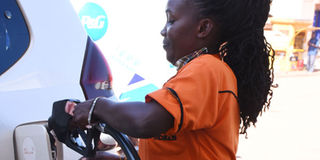Why you should never drive your car on empty

A pump attendant fuels a car in Namuwongo, Kampala, recently. PHOTO/Alex Esagala
What you need to know:
Although the constant reminder to refuel can be annoying, do not ignore your car’s insistence on refuelling because running it on an empty tank may cause irreparable damage.
The consequences of running out of fuel are a sudden loss of power to your engine, potentially on a busy road. This in itself is dangerous. Now consider having to pull over without the use of your engine. Being stranded in your car is always a potentially dangerous situation to be in and not one worth risking.
Damage to the fuel filter and fuel pump
Peter Amadi, a mechanic, warns that driving on an almost empty tank overtime does not only damage the fuel pump but it also wears out the catalytic converter. Your fuel pump is located inside the fuel tank and for it to function well, it has to be covered or wholly immersed in fuel.
“When your fuel pump is not fully soaked in fuel, it will suck up the dirt that settles at the bottom of the tank. Without enough fuel, the fuel pump mortar starts to heat up and this shortens its lifespan. The fuel filter will also not be spared. It will suck up the same dirt from the fuel pump and it will be clogged by dirt,” Amadi explains.
According to Moses Matsiko, a mechanic, one of the signs of a failing or damaged fuel pump is loss of fuel pressure. As the fuel is being pumped from the tank to the engine chamber for combustion while your car is in motion, it will not flow at the same rate it did while still new.
“As a result, the engine will not receive sufficient fuel to burn to complete the engine combustion cycle. It will start to heat up, especially at high speeds. There will be a change in engine temperature and the engine temperature warning light will show on your dashboard indicating a problem with the engine,” Matsiko explains.
Rusting the fuel tank
Besides damaging your fuel pump and fuel filter, driving on an almost empty tank equally damages the tank. Just like a home metallic water tank starts to rust at the bottom if it takes long without receiving rain water, your fuel tank, which is also metallic, starts to rust when you drive on an almost empty tank.
According to Amadi, internal fuel tank rust, just like rust on any part of the car body, starts on small scale and eventually spreads. Before you know it, the fuel tank has developed holes, which may cause fuel leakages.
“To avoid costs of replacing a hollow fuel tank, it is safe to have at least a quarter tank of fuel in your car. Stop the habit of arguing that you understand your car and how much mileage it can take you when the fuel gauge empty light shows,” Amadi advises.
Matsiko, like Amadi, explains that the distance your car can take you from the onset of your empty red light fuel gauge surfacing on your dashboard is determined by the speed at which you are driving, your car’s fuel economy and road condition.
“If you are driving in a traffic jam and the red light pops up, even if your car runs on a 1500cc engine, the fuel economy will drop and the distance it will take you significantly reduces. It will be burning more fuel and covering a short distance compared to the highway where it will be fast and burning less fuel,” Matsiko explains.
According to MachineDesign, an online portal, the driving capability of each car on empty will vary. All cars have different efficiencies based on engine optimisation and vehicle design.
“Do not apply the standard of one vehicle to another. It is a good habit to know the range of your car since driving with low fuel is sometimes unavoidable,” the portal advises.
The case of inaccurate fuel gauge reading
Peter Kasoma, a mechanic, says a motorist should be aware that not all fuel gauges show accurate fuel readings. Certain underlying factors such as a deformed or bent fuel tank (you could have hit on a road hump or pothole accidentally), significantly affects your fuel gauge reading on the dashboard.
“It (fuel gauge) could read that you have a quarter a tank of fuel left yet the tank is almost or already empty. This can lead to getting stuck on the road, sometimes in dangerous places,” Kasoma warns.
In case of an empty fuel tank
If you have a completely empty fuel tank and your car stops while driving, put your hazard lights on and leave the vehicle only if it is safe to do so. If it is not safe to, contact anyone who can help such as a mechanic or friend.
Depending on the terrain and how busy the road is, it may be possible to push your car to the side of the road. You should only do this if there are at least two people to help and you should always remain behind the wheel to control the car. Never push a car on your own or during busy traffic no matter what other people suggest.
If you are by the side of the road and you have run out of fuel, then you should walk to the nearest petrol station. Ensure you lock the car and only leave it if it is parked in a legitimate position.




